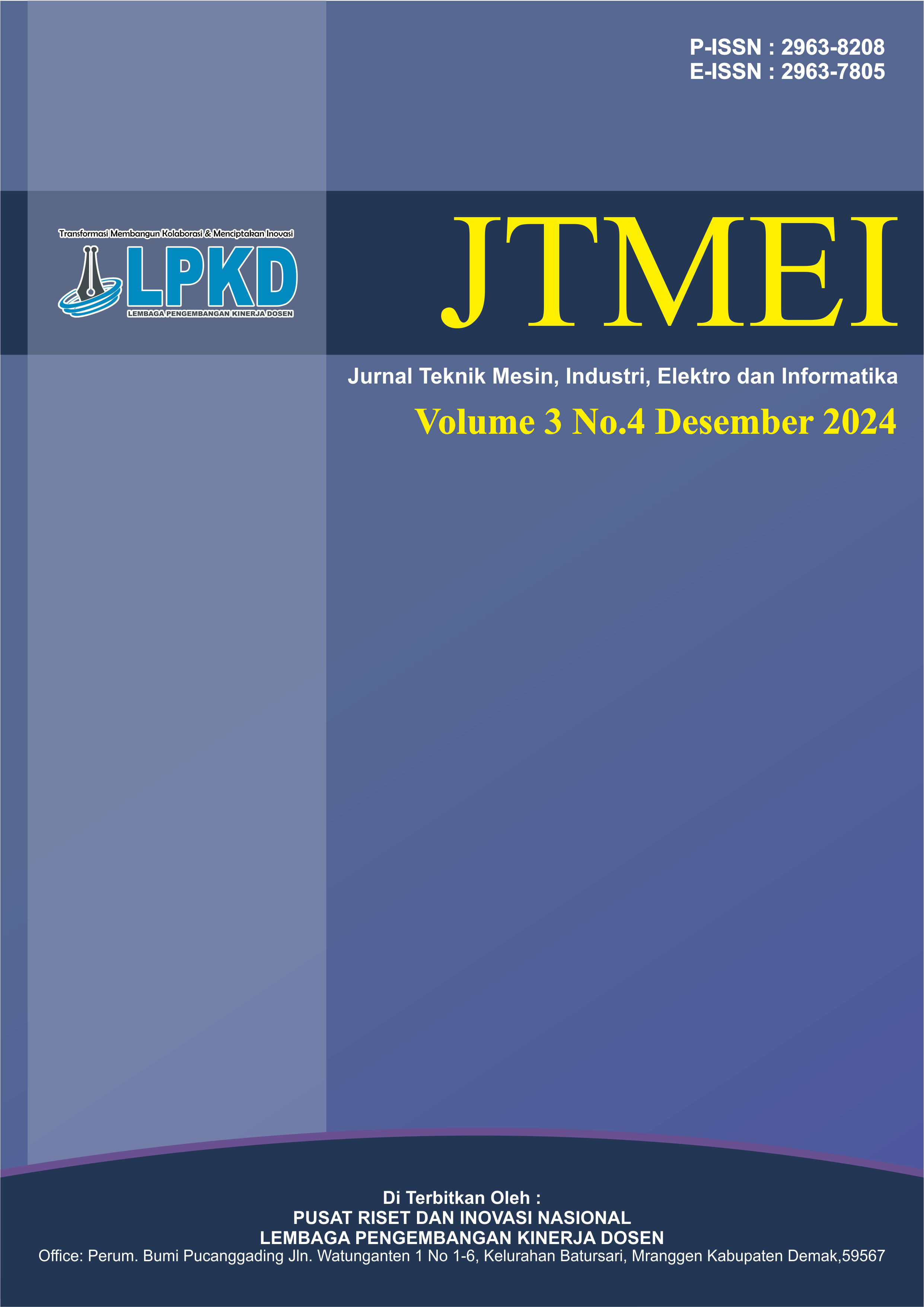Finite Element Analysis of an Active Air-Cooling System on a 30V LiFePO4 Battery for a Home Power Generation System
DOI:
https://doi.org/10.55606/jtmei.v3i4.4298Keywords:
cooling system, LiFePO4 batteries, Thermal managementAbstract
By seeing public awareness of the importance of using renewable energy for the sustainability of their children and grandchildren in the future, it has increased public attraction to sustainable and reliable home power plants. However, there are constraints in the application of sustainable home power generation systems, the integration of lithium iron phosphate (LiFePO4) batteries has become famous for their high energy density and long service life. However, efficient thermal management is essential to maintain performance and extend the life of these batteries. The study focused on optimizing the cooling system layout for 30V LiFePO4 batteries used in home power generation systems. Computational Fluid Dynamics (CFD) and Finite Element Analysis (FEA) software are used to design and evaluate cooling systems. The cooling system in power generation plays a crucial role in maintaining the efficiency and safe operation of power plants. Power generation processes, whether they involve fossil fuels, nuclear energy, or renewable sources, typically generate a significant amount of heat that needs to be managed effectively
Downloads
References
T. Kousksou, P. Bruel, A. Jamil, T. El Rhafiki, and Y. Zeraouli, “Energy storage: Applications and challenges,” Solar Energy Materials and Solar Cells, vol. 120, no. PART A, pp. 59–80, Jan. 2014, doi: 10.1016/J.SOLMAT.2013.08.015.
I. Hadjipaschalis, A. Poullikkas, and V. Efthimiou, “Overview of current and future energy storage technologies for electric power applications,” Renewable and Sustainable Energy Reviews, vol. 13, no. 6–7, pp. 1513–1522, Aug. 2009, doi: 10.1016/J.RSER.2008.09.028.
H. , et al. Chen, ““Progress in Electrical Energy Storage System: A Critical Review",” Progress in Natural Science, vol. 19, pp. 291–312, 2009.
L. F. Cabeza, A. Castell, C. Barreneche, A. De Gracia, and A. I. Fernández, “Materials used as PCM in thermal energy storage in buildings: A review,” Renewable and Sustainable Energy Reviews, vol. 15, no. 3. pp. 1675–1695, Apr. 2011. doi: 10.1016/j.rser.2010.11.018.
“ A.K. Pahdi, K.S. Nanjundaswamy, J.B. Goodenough, J. Electrochem. Soc. 144 (1997) 1188.,” 1977.
“M. Maccario, L. Croguennec, A. Wattiaux, E. Suard, F. Le Cra, C. Delmas, Solid State Ionics 179 (2008) 2020.”.
“ J. Li, W. Yao, S. Martin, D. Vaknin, Solid State Ionics 179 (2008) 2016.”.
W. J. Zhang, “Structure and performance of LiFePO4 cathode materials: A review,” Journal of Power Sources, vol. 196, no. 6. pp. 2962–2970, Mar. 15, 2011. doi: 10.1016/j.jpowsour.2010.11.113.
Aken Derisman, Zikri, and M. R. Fauzi, “Rancang Bangun Kendaraan Listrik Roda Tiga Bertenaga Surya sebagai Kendaraan Niaga,” Jurnal Surya Teknika, vol. 9, no. 2, pp. 481–486, Dec. 2022, doi: 10.37859/jst.v9i2.4417.
“Tantangan dan Masa Depan Tenaga Listrik Fotovoltaik.” [Online]. Available: https://www.researchgate.net/publication/369744460
A. Mannan, S. Kirmani, and I. Akhtar, “Design Methodology of Off-Grid PV System,” J Phys Conf Ser, vol. 2570, no. 1, p. 012004, Aug. 2023, doi: 10.1088/1742-6596/2570/1/012004.
S. Prayogi, T. Elektro, F. Silviana, and Z. P. Fisika, “Volume 5 Nomor 2 Juli 2023 Peningkatan Performa Sel Surya Dengan Sistem Peredam Panas,” Jambura Journal of Electrical and Electronics Engineering, vol. 143.
I. Hadjipaschalis, A. Poullikkas, and V. Efthimiou, “Overview of current and future energy storage technologies for electric power applications,” Renewable and Sustainable Energy Reviews, vol. 13, no. 6–7, pp. 1513–1522, Aug. 2009, doi: 10.1016/J.RSER.2008.09.028.
C. Zhao et al., “Recent advances in high value-added carbon materials prepared from carbon dioxide for energy storage applications,” Carbon Capture Science & Technology, vol. 9, p. 100144, Dec. 2023, doi: 10.1016/J.CCST.2023.100144.
E. Meng, J. Sun, Y. Huang, and H. Tang, “Morphology Evolution and Improved Electrochemical Properties of LiFePO4 Cathode Materials for Li-ion Batteries,” Int J Electrochem Sci, vol. 17, no. 12, p. 221225, Dec. 2022, doi: 10.20964/2022.12.25.
Y. M. Xin, H. Y. Xu, J. H. Ruan, D. C. Li, A. G. Wang, and D. S. Sun, “A Review on Application of LiFePO4 based composites as electrode materials for Lithium Ion Batteries,” Int J Electrochem Sci, vol. 16, no. 6, p. 210655, Jun. 2021, doi: 10.20964/2021.06.33.
E. Meng, J. Sun, Y. Huang, and H. Tang, “Morphology Evolution and Improved Electrochemical Properties of LiFePO4 Cathode Materials for Li-ion Batteries,” Int J Electrochem Sci, vol. 17, no. 12, p. 221225, Dec. 2022, doi: 10.20964/2022.12.25.
S. Y. T. A. S. Y. Nakasone, Engineering Analysis with ANSYS Software, vol. Chapter 2. Butterworth-Heinemann, 2006.
G. C. Onwubolu, Introduction to SOLIDWORKS. 2017. doi: 10.1201/9781315382500.
Downloads
Published
How to Cite
Issue
Section
License
Copyright (c) 2024 Jurnal Teknik Mesin, Industri, Elektro dan Informatika

This work is licensed under a Creative Commons Attribution-ShareAlike 4.0 International License.








